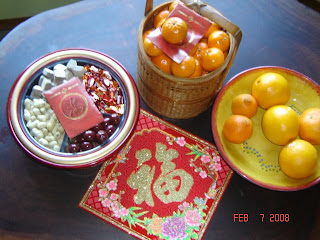
The Chinese believes in the old saying " You are what you eat". Having once been married to a Cantonese household who prized their daily soups more than anything else, I have learnt to make some serious soups. Looking after two young girls who were 11 months apart and trying to be a housewife at the same time was no easy task. And I could really tear my hair out when the kids started fretting and refuse to drink their soups. So, when all else failed, I would name some of my soups some silly names to get them to eat without any problem. One of them is the Booby soup aka Papaya soup. And you know what? It worked! Some people like to use green papayas but I always made mine with riper ones as the soups come out sweeter.
Ingredients:
1/2 papaya that is 75% ripe( here is Oregon, the Mexican Miradol papaya is very similar to those in M'sia), seeded, peeled and cut into 2-inch chunks.
1/2 a chicken carcass,trimmed of all visible fat, deskinned and chopped into half, blanched
*1 portion of pork shoulder the size of an orange,blanched
1/2 cup raw peanuts with skin on
5 seeded dried red dates
1 piece of dried tangerine peel
Method:
Fill your ceramic soup pot 3/4 full with water, cover with a lid and bring to a full boil.
When water is boiling, add the blanched meats first, then the rest of the ingredients.
Let the soup boil on high for an hour but keep an eye on it just in case, it boils over.
Turn the dial to medium heat after an hour and let it simmer for another hour and a half. There should not be a lot of water loss. I find that at the end all the tastes of the ingredients come together and it actually doesn't need any salt at all.
But, if you feel there is some taste lacking, add as desired.
This is a simple but very nutritious soup and I am bias when it comes to making my soups in ceramic pots because they do tend to come out richer in taste. It is important to blanch the meats before you put them in the actual soup pot as the process takes out all the "blood" water and does not make your soup froth. No matter how much you try to trim the meats, there will always be some fat floating around. I always make my soups stand overnight and in the morning, you can easily scoop out all the fat with a ladle. What is left is a clear broth, free of all the nasties. Soups always tastes better if they are let to sit overnight before drinking as more of the essence seeps into the liquid. A pot of soup may last for a couple of days, so make sure that you heat it up in the morning so that it will not go bad.
*Poultry is considered "toxic" and when added to soups should always be accompanied by a small portion of pork about the size of an orange. Pork is believed to neutralize the "toxicity" of the poultry. You never drink chicken soup when you have a cough, instead you have "jue yook jook" or better known as pork porridge.











